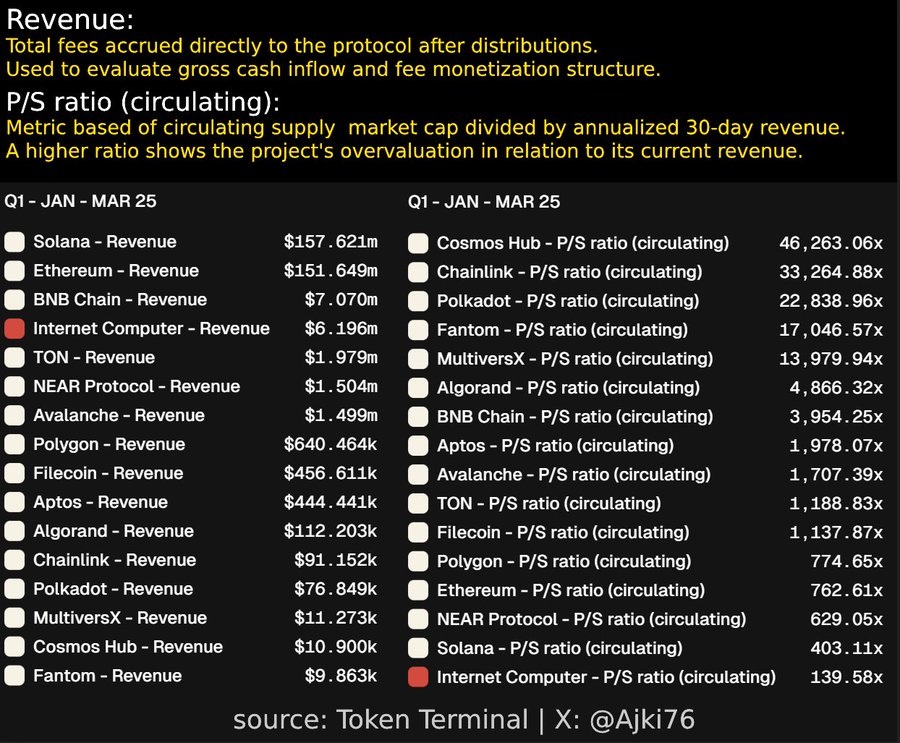Let’s get serious and look at the actual data. That was the message from Ajki on X this week as Internet Computer Protocol (ICP) found itself once again ahead of the blockchain pack—not in flashy headlines or inflated user metrics, but in real-world delivery and retained value. While other chains are still scrambling to prove they’re more than just an interface for hype, ICP has quietly continued to outperform, despite a comparatively small user base.
The story isn’t about vanity metrics. ICP doesn’t claim tens of millions of users. Its figures sit in the low hundreds of thousands. Still, when it comes to how much value actually stays within the chain and how much is sent off to pay for external infrastructure, ICP is already doing what the rest are pretending to aim for. The recent numbers suggest that even when adjusted for generous scenarios—like slashing the revenue of competitors such as $BOB by 60%—the difference remains substantial. The implication: ICP’s ecosystem is working efficiently while others are haemorrhaging value.

So why are other blockchains missing the mark? It comes down to architecture. A good chunk of them, despite years of updates and funding rounds, still rely heavily on centralised services. Smart contracts might sit onchain, but the real action—the computation, storage, firewalls, content delivery—usually happens on traditional Web2 infrastructure. That’s a leak. One that’s constantly draining value from their ecosystems. A dApp might generate a lot of activity, but that activity comes at a cost: cloud services, server hosting, data management tools, and every other modern IT convenience that’s not actually native to a blockchain.
That means the money goes to someone else. Whether it’s AWS, Google Cloud, or another provider, these chains are effectively funnelling large parts of their revenue into Web2 ecosystems. What ends up happening is that decentralised finance runs on centralised rails, and the decentralised web becomes just another user of a handful of centralised platforms.
ICP’s take is different. It’s one of the few projects that’s genuinely built the full stack onchain. That includes everything from smart contract logic to frontend hosting, data storage, and beyond. Its architecture isn’t trying to piggyback off traditional services—it’s replacing them. This approach ensures that all value created within the system, stays within the system. Developers deploy dApps that actually live on the chain, not ones that merely touch it from the outside. And users interact with services that don’t need to hop through centralised servers before doing anything meaningful.
There’s also a practical efficiency at play. When everything is integrated onchain, developers and users alike aren’t left worrying about bridging, third-party APIs, or keeping multiple service contracts in check. Costs are streamlined, performance becomes more predictable, and the security model benefits from blockchain-native design throughout. It’s less about plugging gaps with centralised fixes and more about designing from scratch with decentralisation as the foundation.
Other chains might argue they’re heading in this direction. Some are experimenting with decentralised storage or alternative computation models. But most are still far from eliminating their reliance on Web2. And that reliance isn’t just a technical detail—it’s a business liability. The more these systems depend on external services, the harder it is to offer genuinely permissionless, censorship-resistant platforms. And the harder it is to explain to users where their data is going, or who’s profiting from their activity.
Ajki’s post has cut through the noise. It’s not about marketing gloss or speculative engagement metrics. It’s about performance, architecture, and accountability. “Numbers don’t lie. Hype fades. Results don’t,” he wrote—and the numbers from ICP are doing all the talking.
There’s also a wider point being made: longevity in the blockchain world depends not just on attracting users, but on retaining value. Many of the projects currently making headlines were launched long before ICP. They’ve had more time to iterate, more time to scale, and in some cases more institutional support. Yet despite all that, they’re still stuck relying on infrastructure that doesn’t belong to them. And it shows in the bottom line.
ICP might not be trying to dominate the conversation with grand claims. But what it is doing—retaining more value, running more components natively onchain, and offering developers a full suite that’s actually decentralised—could end up being the deciding factor in who lasts and who fades. Because once you strip away the interface and the jargon, what really matters is whether a project can function independently, deliver real utility, and avoid outsourcing its core value to someone else’s servers.
The future of Web3 likely won’t be decided by who shouts the loudest or who has the most aggressive token campaign. It’ll come down to sustainability, infrastructure design, and where the money ends up. And on those fronts, ICP has taken a very different path—one that may well outlast the noise.


